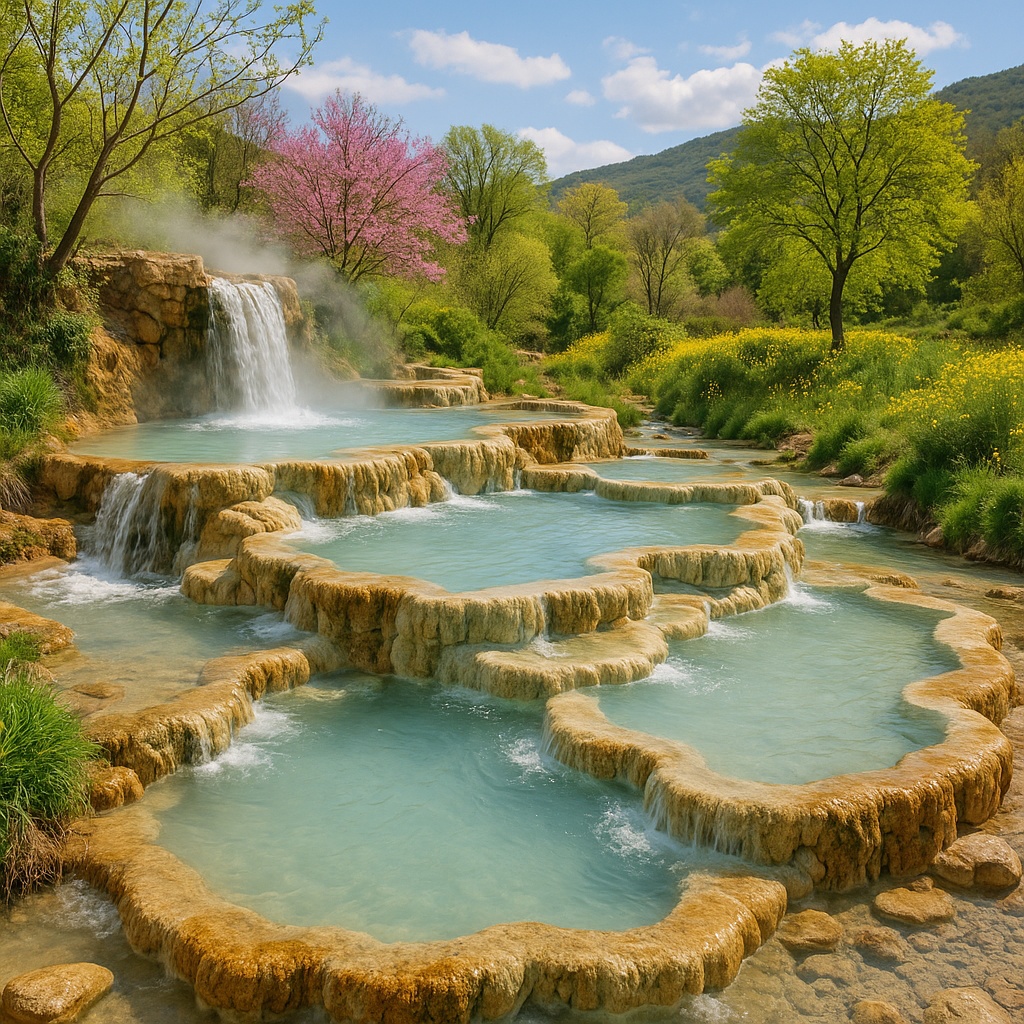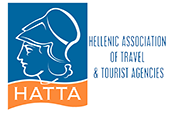The Ultimate Guide for Spa Tours and Thermal Springs in Peloponnese : Healing Waters of Ancient Greece
Let me spill the beans about something extraordinary that most travelers miss when visiting Greece. After spending the better part of my life (yep, over 20 years!) guiding curious souls through the Peloponnese, I've fallen head over heels for our thermal springs.
While tourists are busy snapping selfies at ancient ruins, these healing waters—the same ones that soothed Hippocrates and his pals—sit bubbling away, largely undiscovered. It's about time I shared my insider secrets about these magical thermal springs in Peloponnese that have been quietly healing folks since before Instagram was even a twinkle in the universe's eye.

The Ancient Healing Tradition of Peloponnese's Thermal Waters
Mother Nature blessed the Peloponnese peninsula with hot springs galore—a happy accident from the geological drama that crafted our jaw-dropping landscapes. Our ancestors weren't fools; they spotted these thermal springs in Peloponnese thousands of years ago and thought, "Hey, let's build fancy bath houses here!" These weren't just places to get clean—they were the original social networks.
What makes these thermal springs in Peloponnese worth writing home about? It's their mineral cocktail—a natural brew of sulfur, sodium, potassium, calcium, and magnesium that bubbles up from the earth's core at a toasty 25°C to 65°C. That's bath-perfect all year round, no water heater required!
I've watched countless visitors limp into these thermal springs in Peloponnese and practically dance out afterward. The transformation is wild—skin conditions clear up, creaky joints quiet down, circulation improves, and that perpetual frown of modern life? Gone after a good soak. But there's something else too—something almost mystical about floating in the exact same waters that have comforted humans since the dawn of civilization.
Loutraki: The Crown Jewel of Peloponnese Thermal Springs
Just an hour's drive from Athens (close enough for a day trip, far enough to escape the tourist hordes) sits Loutraki. The name itself—derived from "loutro" meaning bath—is a dead giveaway about what makes this place special. This is the granddaddy of thermal springs in Peloponnese.
The Modern Thermal Spa Experience at Loutraki
The showstopper here is the Loutraki Thermal Spa—where ancient healing meets modern luxury. The water bubbles up at a delicious 30°C, packed with calcium, magnesium, and sodium goodness. I've watched this place evolve from humble beginnings into something that would make the ancient Greeks drop their togas in amazement.
The hydrotherapy section feels like something from a sci-fi film with multiple pools, underwater jets, and massage stations that'll make you moan inappropriately in public. For the spa aficionados, they offer:
• Individual therapeutic baths tailored to your body's complaints
• Mud treatments using clay so mineral-rich you might grow an inch taller
• Breathing treatments that'll have your lungs feeling brand new
• Clever combinations of old-school thermal water with new-school physiotherapy
• Beauty treatments that leverage these miracle waters (move over, expensive face creams!)
Here's a tip worth its weight in gold: visit on weekday mornings between 9-11 AM. That's when you'll have the place almost to yourself, especially important during summer when Athens empties out on weekends as everyone flees to Loutraki.
Beyond the Spa: Loutraki's Natural Springs
While the fancy spa has all the bells and whistles, true adventure-seekers should hightail it about 4 kilometers north of town. There, you'll find a natural hot spring that flows directly into a rocky basin before mingling with the Gulf of Corinth. The sensation of warm mineral water meeting cool sea creates a tinglyy, bizarre-in-the-best-way experience.
This hidden gem of thermal springs in Peloponnese remains blissfully under the radar. Show up early morning and your only companions might be a few local grandpas and grandmas, taking their daily constitutional soak—a health routine they swear has kept them spry well into their 90s. No fancy reception desk, no piped-in relaxation music—just you, some elderly Greek wisdom, and thermal waters that have been doing their thing since before the Trojan War.
Kaiafas: The Mystical Thermal Lake of Western Peloponnese
Journey to the western Peloponnese and you'll discover my personal obsession: Kaiafas. Near the birthplace of the Olympic Games lies a completely different kind of thermal springs in Peloponnese experience centered around a magical lake that seems straight out of a fairy tale.
The Unique Geology of Kaiafas Thermal Lake
What makes Kaiafas utterly bewitching is its setting. Hot springs burble up from the foot of Mount Lapitha, feeding into a natural lake that's separated from the Ionian Sea by nothing more than a sliver of pine-covered land. The constant inflow of thermal water keeps the lake perfectly toasty year-round.
The springs themselves emerge from tiny caves at roughly 33°C, rich in sulfur compounds that—let's be honest—smell like Satan's egg salad. First-timers often wrinkle their noses, but I always tell them: "That stink is the smell of healing!" Those sulfur compounds work wonders for skin issues and rheumatic conditions. Sometimes the best medicine doesn't smell like roses.
Kaiafas Thermal Spa Facilities
The spa facilities at Kaiafas strike a perfect balance—natural enough to feel authentic but developed enough that you're not just squatting in a mud puddle. The main building, a 1960s construction that's been spruced up over the decades, houses private bathing cabins where you can soak in mineral-rich waters in blissful solitude.
Unlike Loutraki's medical approach, Kaiafas keeps things refreshingly simple. The focus is on direct immersion in these legendary thermal springs in Peloponnese with minimal fuss. It's an approach that particularly resonates with folks seeking connection to traditional healing methods rather than a full-service spa day.
Insider secret: Kaiafas operates seasonally, typically May through October. Yes, technically it's open year-round, but services dwindle during winter months, and some areas close for repairs. Always call ahead if visiting between November and April—nothing worse than driving all that way to find locked doors!
The Natural Experience: Swimming in Kaiafas Lake
For the full-monty Kaiafas experience, you simply must combine formal spa treatments with a swim in the thermal lake itself. The lake's unique ecosystem, where hot and cold waters mingle, creates fascinating temperature pockets that you can discover as you paddle around.
Late afternoon is pure magic here—day-trippers have vanished, golden light filters through the pine forest, and steam rises from the lake surface like something from a fantasy novel. These thermal springs in Peloponnese create a scene so enchanting that many clients tell me years later: "Remember that evening at Kaiafas? I still dream about it."
Hidden Thermal Treasures: Lesser-Known Springs of the Peloponnese
While Loutraki and Kaiafas get the limelight, the Peloponnese hides several secret thermal springs that offer more intimate experiences for travelers willing to venture off the beaten spa circuit.
Methana: The Volcanic Peninsula
The Methana peninsula is essentially a sleeping volcano that juts into the Saronic Gulf, its geothermal tantrums producing several hot springs. The main spa in Methana town offers no-frills facilities for enjoying sulfur-rich waters that work wonders for creaky joints and stubborn coughs.
What most visitors miss is the natural hot spring at Pausanias Baths, about 2 kilometers from town. Here, thermal waters bubble directly through rocky shoreline, creating natural hot tubs that mix with seawater. A short hike keeps the Instagram crowds away, making these thermal springs in Peloponnese relatively peaceful even during high season.
The Hidden Springs of Mani Peninsula
Deep in the southernmost reaches of the Peloponnese, the rugged Mani peninsula—land of tower houses and blood feuds—harbors several tiny thermal springs that international tourists rarely discover. Near the village with the tongue-twister name Kainourio Oitylo, a small hot spring emerges directly onto a pebble beach, creating a delightful spot to alternate between warm mineral waters and refreshing sea dips.
These off-grid thermal springs in Peloponnese have no facilities whatsoever—no changing rooms, no attendants, no entrance fees—just the raw experience that connects modern visitors to how Greeks have enjoyed thermal waters since time immemorial. For my tour groups visiting these remote spots, I pack picnic feasts of local cheeses, olives, and fresh bread, turning a simple thermal soak into a day-long celebration of Greek pleasure principles.
Killini Thermal Springs: The Forest Retreat
In northwestern Peloponnese, near the port town of Killini, another thermal gem hides among dense forest. The Killini thermal springs feature waters rich in hydrogen sulfide and calcium, emerging at a gentle 25°C.
The modest spa facility here looks frozen in time—a glimpse into mid-20th century Greek spa culture before wellness became a luxury industry. The surrounding forest creates a hushed sanctuary where the modern world feels deliciously distant. These thermal springs in Peloponnese preserve the democratic spirit of thermal tourism—healing waters for everyone, not just those with platinum credit cards.
Combining Thermal Wellness with Cultural Exploration
One of the magical things about thermal springs in Peloponnese is their proximity to mind-blowing archaeological sites and historic towns. This allows clever travelers to create itineraries that nourish both body and history-loving soul.
Loutraki and Ancient Corinth: Healing Waters and Classical Ruins
When guiding groups through the thermal springs in Peloponnese near Loutraki, I always suggest this perfect pairing: morning spent soaking in thermal treatments followed by afternoon exploring Ancient Corinth, just a 20-minute drive away. There's something poetically balanced about rejuvenating in modern spa facilities and then wandering through one of Greece's most significant ancient cities.
The archaeological site of Ancient Corinth features the imposing Temple of Apollo, an extensive Roman Agora, and a museum that'll make history buffs weak at the knees. After a morning of relaxation in thermal springs in Peloponnese, visitors typically have the energy to tackle the climb to Acrocorinth, the ancient fortress perched above the main site. On clear days, the views stretch all the way to Athens—worth every drop of sweat on the uphill hike.
Kaiafas and Ancient Olympia: Olympic Heritage and Thermal Healing
Visitors enjoying the thermal springs in Peloponnese at Kaiafas are perfectly positioned to include Ancient Olympia in their adventure—the birthplace of the Olympic Games lies just 30 kilometers away. I typically suggest hitting Olympia in the morning when temperatures are kinder for exploring the extensive ruins, followed by an afternoon of thermal bliss at Kaiafas.
This combination works brilliantly for families with kids, who often enjoy the mythological connections of Olympia but develop "ancient ruins fatigue" after a couple of hours. The promise of a swim in Kaiafas lake afterward provides perfect motivation for young travelers to engage with history before splashing in thermal springs in Peloponnese.
Methana and Epidaurus: Wellness Through the Ages
For visitors fascinated by the historical connections between medicine, healing, and thermal waters, I recommend pairing Methana's thermal springs with the nearby Sanctuary of Asklepios at Epidaurus. This UNESCO site was the Mayo Clinic of the ancient world, where patients sought divine healing through dream therapy, exercise, and treatments that ranged from sensible to bizarre.
The contrast between ancient and modern wellness approaches creates a fascinating lens through which to experience both sites. The famous Epidaurus theater, with acoustics so perfect you can hear a whisper from the top tier, provides cultural icing on the cake of your thermal springs in Peloponnese experience.
Practical Information for Planning Your Thermal Springs Tour
Seasonal Considerations
The Peloponnese enjoys a climate that makes visiting thermal springs in Peloponnese possible year-round, but each season offers distinct advantages:
• Spring (April-June): My personal favorite—comfortable temperatures, wildflowers carpeting hillsides around many springs, and fewer tourists than high summer. Natural settings like Kaiafas Lake look like they've been art-directed during this season.
• Summer (July-August): Peak season brings crowds to thermal facilities, especially Loutraki. However, there's a delicious contrast between scorching summer air and cooler thermal waters (many springs actually feel refreshingly cool compared to the summer heat).
• Autumn (September-October): Another golden period for thermal springs in Peloponnese—warm days, crisp evenings, and dwindling crowds. The surrounding landscapes often turn amber and gold, adding visual drama to many spring locations.
• Winter (November-March): The most authentic time to experience thermal springs as locals do. Major thermal springs in Peloponnese remain open, though smaller facilities may reduce hours. There's something magical about steam rising from warm mineral pools while surrounded by winter landscapes—like bathing in a snow globe!
Accessibility from Major Cities
Most thermal springs in Peloponnese can be reached within a reasonable drive from major cities:
• From Nafplio: Loutraki is roughly 1.5 hours by car—feasible as a day trip. Methana is even closer, about an hour away through gorgeous countryside.
• From Kalamata: Kaiafas is about 2 hours northeast, while some of the Mani peninsula springs are just 60-90 minutes south.
• From Patras: Killini springs are approximately 1 hour south, while Kaiafas is about 2 hours away.
• From Athens: While not technically in the Peloponnese, Athens serves as the arrival point for most visitors. Loutraki is just an hour from Athens, making these thermal springs in Peloponnese the most accessible option for the time-strapped traveler.
FAQ: Your Questions About Peloponnese Thermal Springs Answered
Which thermal springs in Peloponnese are the most developed?
Loutraki wins the development crown, offering comprehensive facilities with medical supervision, diverse treatments, and excellent amenities. Kaiafas comes second with good basic facilities but a more traditional approach. Methana and Killini provide simpler experiences with fewer bells and whistles but plenty of authentic charm.
Can I visit Peloponnese thermal springs year-round?
You betcha! The major thermal springs in Peloponnese operate throughout the year, though some reduce hours during winter. Natural springs and thermal lakes remain accessible in all seasons but are most comfortable from spring through early autumn. Winter visits offer a more authentic experience alongside local regulars rather than summer tourists.
How do Loutraki thermal springs compare to Kaiafas?
These thermal springs in Peloponnese offer dramatically different experiences. Loutraki provides a medicalized, comprehensive spa experience with numerous treatments beyond simple bathing. Kaiafas offers a nature-immersed experience centered around its unique thermal lake. Loutraki's waters contain more calcium and magnesium, while Kaiafas features sulfur-rich waters with that distinctive "rotten egg" aroma that means healing is happening!
Are there natural hot springs in Peloponnese I can visit for free?
Absolutely! Several natural thermal springs in Peloponnese can be accessed without spending a drachma, including the shoreline springs at Methana (Pausanias Baths), spots along the Mani peninsula, and certain areas around Kaiafas Lake. The trade-off: no changing rooms, no freshwater showers—just you and nature in raw communion. For comfort, I typically suggest paying the modest entrance fees at developed sites, which usually cost less than a fancy coffee in Athens.
Can I combine thermal spring visits with ancient site tours?
That's the beauty of the Peloponnese—these thermal springs in Peloponnese sit near extraordinary archaeological treasures! Loutraki pairs perfectly with Ancient Corinth, Kaiafas with Ancient Olympia, and Methana with Epidaurus. Many of my custom tours follow a "ruins in the morning, relaxation in the afternoon" pattern that satisfies both the history buff and the wellness seeker in all of us.
What health conditions do Peloponnese thermal springs help with?
While each spring has its special properties, thermal springs in Peloponnese generally show benefits for:
• Creaky joints and arthritis (your knees will thank you)
• Skin conditions including psoriasis and eczema
• Respiratory issues (especially the sulfur springs)
• Poor circulation
• Muscle and joint injuries
• The modern plague of stress and anxiety
Always chat with your doctor before treating specific conditions with thermal therapy!
🏺 Discover Ancient Greece With Expert Guides
Transform your historical knowledge into unforgettable archaeological experiences
Historical Tours
UNESCO Archaeological Sites
Peloponnese Tours
25+ Local Experiences
Adventure Tours
Outdoor Activities








